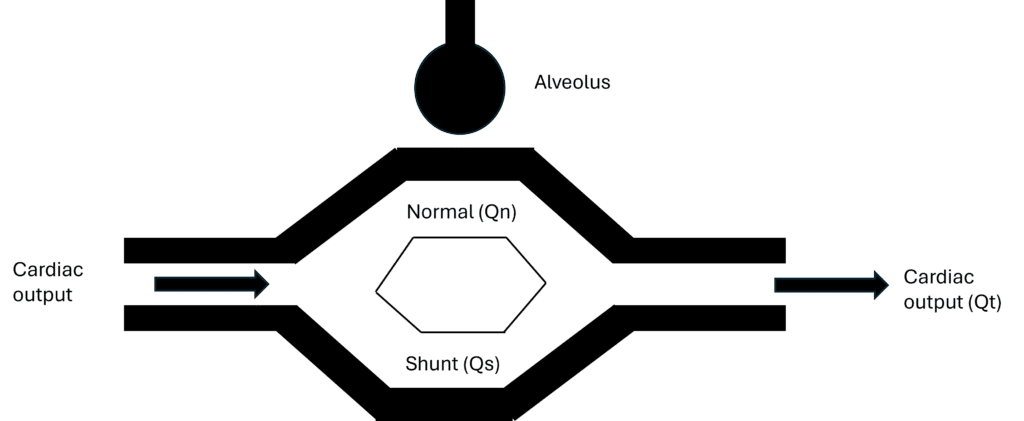A ‘shunt’ describes a situation in which blood enters the arterial tree without passing through ventilated areas of the lung. Shunts can be subclassified into extrapulmonary and intrapulmonary.
Here on TeachMeAnaesthetics, we aim to cover the absolute key details of high yield exam topics, which can then be supplemented with further reading as needed.
In this short article, we will discuss the significance of shunts in the respiratory system, and walk through the derivation of the shunt equation, which may be expected of you in the Primary FRCA.
Shunt
A ‘shunt’ describes a situation in which blood enters the arterial tree without passing through ventilated areas of the lung. In the lung, a shunt can be more specifically considered as a region of lung tissue that is perfused but not ventilated.
This is in direct contrast to dead space, which is an area of lung tissue which is ventilated but not perfused.
Classes of Shunt
As alluded to earlier, shunts can be classified into intrapulmonary and extrapulmonary. Additionally, these can be subclassified into physiological and pathological.
Intrapulmonary
- Physiological: Bronchial arterial blood directly entering the pulmonary veins.
- Pathological: Lung collapse, bronchiolar obstruction (any cause of local failure of ventilation)
Extrapulmonary
- Pathological: Cardiac right to left shunting e.g. Eisenmenger’s syndrome
The Shunt Equation
Unfortunately, the shunt equation is fair game. It needs to be memorised, and it is helpful to be able to derive it too.
Consider the situation in which blood arrives at the lung, with some passing directly adjacent to the alveolus but some bypasses the alveolus (the shunt fraction).
Blood with venous oxygen content (CvO2) enters from the left, before the flow is divided into two sections. Some passes by the alveolus to become oxygenated (CcO2, capillary oxygen content), while some is shunted and retains its venous oxygen content. This all collects in the arterial tree, with a composite arterial content (CaO2).
Using Fick’s law, we can equate the oxygen content on either side of this system:
Qt.CaO2 = Qn.CcO2 + Qs.CvO2
Now, we know that Qn must be equal to Qt-Qs:
Qt.CaO2 = (Qt-Qs)CcO2 + Qs.CvO2
Expanding gives:
Qt.CaO2 = Qt.CcO2 – Qs.CcO2 + Qs.CvO2
Separating Qs and Qt on opposite sides of the equation and collecting terms gives:
Qs (CcO2 – CvO2) = Qt (CcO2 – CaO2)
Which can be rearranged into the shunt equation:
Qs/Qt = (CcO2 – CaO2)/(CcO2 – CvO2)
Suggested Reading
Chapter 5. West’s Respiratory Physiology. 10th edition. West. 2016.
Chapter 7. The Primary FRCA structured oral examination Study Guide 1. 2nd edition. Wijayasiri and McCombe. 2016.
